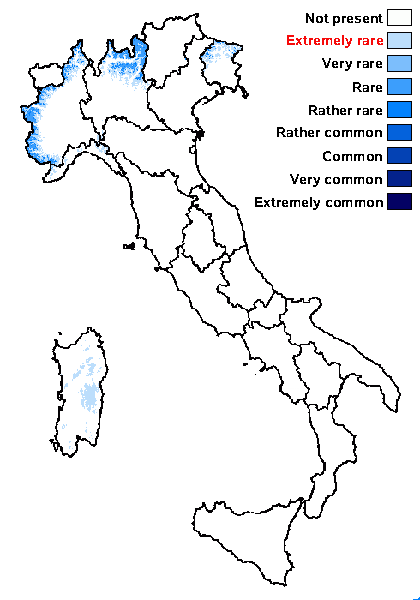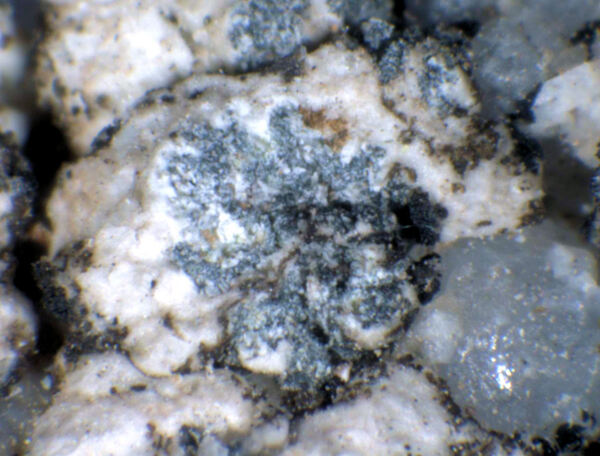Glaucomaria bicincta var. sorediata (Flot.) ined.
provisionally placed here, ICN Art. 36.1b. . Basionym: Zeora glaucoma f. sorediata Flot. - Lich. Exs., 369: 123, 1849.
Synonyms:
Distribution: N - Frl, Lomb, Piem (TSB 33165), Lig (TSB 33474). C - Sar.
Description: Thallus crustose, episubstratic, rimose-areolate to slightly verrucose, whitish to pale bluish-grey, often somehow shiny, sometimes delimited by a dark prothallus, sorediate. Areoles flat to rarely convex when old, ecorticate, smooth, epruinose, the peripheral ones often elongate and marginally darker bluish-grey, the central ones bearing blue-grey, flat to convex soralia. Apothecia usually present, lecanorine, at fist subimmersed, then sessile, 0.5-1.5 mm across, with a dark brown to brown-black, but heavily bluish grey-pruinose, flat to convex disc, a thin, persistent, smooth, often wavy, usually finally excluded thalline margin, and an evident, blue-black, sinuous parathecial ring. Thalline exciple pseudocorticate, with numerous algal cells, and with both large and small crystals, the latter soluble in K; proper exciple conspicuous, dark in outer and upper parts, colourless within, lacking crystals; epithecium brown to dark brown, with crystals, both pigment and crystals dissolving in K; hymenium colourless, not inspersed with oil droplets; paraphyses slightly thickened apically; hypothecium colourless, not inspersed. Asci 8-spored, clavate, very thin-walled, with a K/I+ blue, tall tholus penetrated by a faintly amyloid apical cushion, the wall K/I-, surrounded by a K/I+ blue outer layer, Lecanora-type. Ascospores 1-celled, hyaline, ellipsoid, 9-14 x 5-8 µm, the wall <1 µm thick. Photobiont chlorococcoid. Spot tests: thallus and apothecial margin K+ yellow, C-, KC-, P- or P+ pale yellow; apothecial disc C+ yellow-orange, C+ orange. Chemistry: atranorin (major), roccellic acid (major), arthothelin (minor or absent), chloroatranorin (minor), eugenitol (minor), sometimes thiophanic acid; pruina of apothecia with sordidone (major). Note: on vertical or rain-sheltered surfaces of siliceous rocks, probably widespread throughout the Alps, but overlooked, and certainly not common; also known from the Mediterranean mountains.
Growth form: Crustose
Substrata: rocks
Photobiont: green algae other than Trentepohlia
Reproductive strategy: mainly asexual, by soredia, or soredia-like structures (e.g. blastidia)
In underhangs rarely wetted by rain
Commonnes-rarity: (info)
Alpine belt: rare
Subalpine belt: rather rare
Oromediterranean belt: extremely rare
Montane belt: extremely rare
Submediterranean belt: absent
Padanian area: absent
Humid submediterranean belt: absent
Humid mediterranean belt: absent
Dry mediterranean belt: absent

Predictive model
Herbarium samples
Growth form: Crustose
Substrata: rocks
Photobiont: green algae other than Trentepohlia
Reproductive strategy: mainly asexual, by soredia, or soredia-like structures (e.g. blastidia)
In underhangs rarely wetted by rain
Commonnes-rarity: (info)
Alpine belt: rare
Subalpine belt: rather rare
Oromediterranean belt: extremely rare
Montane belt: extremely rare
Submediterranean belt: absent
Padanian area: absent
Humid submediterranean belt: absent
Humid mediterranean belt: absent
Dry mediterranean belt: absent

Predictive model
| Herbarium samples |




